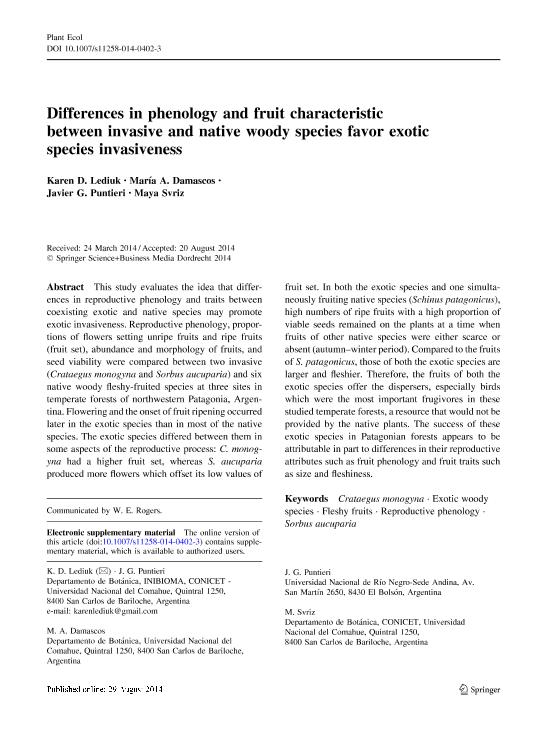Artículo
Differences in phenology and fruit characteristic between invasive and native woody species favor exotic species invasiveness
Fecha de publicación:
12/2014
Editorial:
Springer
Revista:
Plant Ecology
ISSN:
1385-0237
e-ISSN:
1573-5052
Idioma:
Inglés
Tipo de recurso:
Artículo publicado
Clasificación temática:
Resumen
This study evaluates the idea that differences in reproductive phenology and traits between coexisting exotic and native species may promote exotic invasiveness. Reproductive phenology, proportions of flowers setting unripe fruits and ripe fruits (fruit set), abundance and morphology of fruits, and seed viability were compared between two invasive (Crataegus monogyna and Sorbus aucuparia) and six native woody fleshy-fruited species at three sites in temperate forests of northwestern Patagonia, Argentina. Flowering and the onset of fruit ripening occurred later in the exotic species than in most of the native species. The exotic species differed between them in some aspects of the reproductive process: C. monogyna had a higher fruit set, whereas S. aucuparia produced more flowers which offset its low values of fruit set. In both the exotic species and one simultaneously fruiting native species (Schinus patagonicus), high numbers of ripe fruits with a high proportion of viable seeds remained on the plants at a time when fruits of other native species were either scarce or absent (autumn–winter period). Compared to the fruits of S. patagonicus, those of both the exotic species are larger and fleshier. Therefore, the fruits of both the exotic species offer the dispersers, especially birds which were the most important frugivores in these studied temperate forests, a resource that would not be provided by the native plants. The success of these exotic species in Patagonian forests appears to be attributable in part to differences in their reproductive attributes such as fruit phenology and fruit traits such as size and fleshiness.
Archivos asociados
Licencia
Identificadores
Colecciones
Articulos(INIBIOMA)
Articulos de INST. DE INVEST.EN BIODIVERSIDAD Y MEDIOAMBIENTE
Articulos de INST. DE INVEST.EN BIODIVERSIDAD Y MEDIOAMBIENTE
Citación
Lediuk, Karen Daniela; Damascos, Maria A.; Puntieri, Javier Guido; Svriz, Maya; Differences in phenology and fruit characteristic between invasive and native woody species favor exotic species invasiveness; Springer; Plant Ecology; 215; 12; 12-2014; 1455-1467
Compartir




